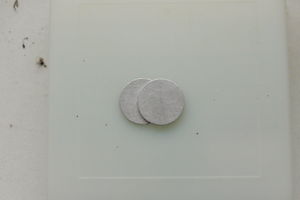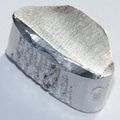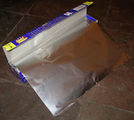Aluminium
 Aluminum metal sample. | |||||
| General properties | |||||
|---|---|---|---|---|---|
| Name, symbol | Aluminium, Al | ||||
| Appearance | Silvery white | ||||
| Aluminium in the periodic table | |||||
| |||||
| Atomic number | 13 | ||||
| Standard atomic weight (Ar) | 26.9815385(7) | ||||
| Group, block | (boron group); p-block | ||||
| Period | period 3 | ||||
| Electron configuration | [Ne] 3s2 3p1 | ||||
per shell | 2, 8, 3 | ||||
| Physical properties | |||||
| Silvery-white | |||||
| Phase | Solid | ||||
| Melting point | 933.47 K (660.32 °C, 1220.58 °F) | ||||
| Boiling point | 2743 K (2470 °C, 4478 °F) | ||||
| Density near r.t. | 2.7 g/cm3 | ||||
| when liquid, at | 2.375 g/cm3 | ||||
| Heat of fusion | 10.71 kJ/mol | ||||
| Heat of | 284 kJ/mol | ||||
| Molar heat capacity | 24.2 J/(mol·K) | ||||
| pressure | |||||
| Atomic properties | |||||
| Oxidation states | +3, +2, +1, −1, −2 (an amphoteric oxide) | ||||
| Electronegativity | Pauling scale: 1.61 | ||||
| energies |
1st: 577.5 kJ/mol 2nd: 1816.7 kJ/mol 3rd: 2744.8 kJ/mol | ||||
| Atomic radius | empirical: 143 pm | ||||
| Covalent radius | 121±4 pm | ||||
| Van der Waals radius | 184 pm | ||||
| Miscellanea | |||||
| Speed of sound thin rod | 5,000 m/s (at ) (rolled) | ||||
| Thermal expansion | 23.1 µm/(m·K) (at 25 °C) | ||||
| Thermal conductivity | 237 W/(m·K) | ||||
| Electrical resistivity | 28.2 Ω·m (at 20 °C) | ||||
| Magnetic ordering | Paramagnetic | ||||
| Young's modulus | 70 GPa | ||||
| Shear modulus | 26 GPa | ||||
| Bulk modulus | 76 GPa | ||||
| Poisson ratio | 0.35 | ||||
| Mohs hardness | 2.75 | ||||
| Vickers hardness | 160–350 MPa | ||||
| Brinell hardness | 160–550 MPa | ||||
| CAS Registry Number | 7429-90-5 | ||||
| History | |||||
| Prediction | Antoine Lavoisier (1787) | ||||
| Discovery and first isolation | Hans Christian Ørsted (1825) | ||||
| Named by | Humphry Davy (1807) | ||||
Aluminium (or aluminum) is a strong and light metal with the symbol Al and atomic number 13, well known for its high chemical reactivity and its striking reluctance to display it due to its tendency to passivate. It is commonly and easily found in many household items, and is commonly used as a reductor in many syntheses, being the de facto reducer in thermite mixtures.
Contents
Properties
Physical
Physically, aluminium is a typical metal. It is silver, shiny and a good conductor of heat and electricity. Its melting point is 660 degrees Celsius. This temperature is in the upper range of what is achievable in a home chemistry lab and is the highest melting common metal that an amateur is easily able to melt and forge.
Chemical
Aluminium forms a transparent passivating layer of aluminium oxide upon contact with air. This layer may be removed by simply scratching the surface, or the formation of the layer can be prevented by adding molten gallium metal. With the layer removed, aluminium's strong reducing properties become apparent.
Aluminium will react with strong acids to form its corresponding salt, except nitric acid, where a passivation layer prevents reaction.
Hydroxide solutions and molten alkali hydroxides react violently with the metal, producing the aluminate ion and hydrogen gas.
- 2 Al + 2 NaOH + 6 H2O → 2 NaAl(OH)4 + 3 H2
Aluminium is also oxidized by the tetrachlorocuprate ion and strongly acidic solutions containing chlorides.
Aluminium will react with methanol, forming aluminium methoxide and releasing hydrogen. It will only react with ethanol in the presence of iodine or mercuric chloride, in dry conditions (see Aluminium triethoxide synthesis).
Availability
A rather crude form of aluminium suitable for many reactions is found as aluminum foil for kitchen use. It is recommended that the cheapest brand possible is purchased, as it is less likely to be alloyed or mixed with additives, and the metal may need to be degreased with acetone. These are especially important if the metal is being made into aluminum powder. Certain brands of foil such as Reynolds are typically coated on one side with a plastic, which can be dissolved off by using acetone or xylene.
Computer heat sinks are usually composed of aluminium, and are often obtained as a byproduct of electronic recycling. Other electronic devices that contain aluminium in large amounts are hard drive carcasses, electrolytic capacitors (both the carcass and the inner foil), computer board frames, some transistor heatsinks, etc. Aluminium power cables are also a source of aluminium, although they're not 100% pure aluminium, but rather type 1350 or 1370 alloys. Discarded pieces can sometimes be found around transmission towers. Most of these are slightly impure due to additives in the metal.
Aluminium serves many uses, and most construction jobs will use the metal somewhere. If you find a light metal and a magnet does not stick to it, chances are that it is aluminium. However, many lightweight metal objects can also be made out of other special alloys or polymers, so it's better to analyse the metal first. Lightweight metal pencil sharpeners however tend to be made of magnesium (with 3% aluminium) instead of aluminium.
Soft drink cans are also a source (although in some countries steel drink cans are also available) and are a popular option when melting down the metal to form ingots or similar. These cans may contain a few percent manganese.
Aluminium powder can be found at hardware stores as aluminium paint, mixed with an organic solvent, usually toluene. A special form of aluminium powder, called German Dark Aluminium, can be purchased online or prepared at home. This type of aluminium powder is mixed with charcoal dust to prevent the oxidation of aluminium particles. Because of this and the fact that is granules are smaller, it is very reactive.
Preparation
Preparation of metallic aluminium is not viable in a home setting, as it requires a huge amount of electricity to perform molten electrolysis on aluminium oxide dissolved in cryolite (sodium aluminium fluoride) at close to 1000 degrees Celsius. This is ironic, as the Hall–Héroult process was developed by Charles Martin Hall in the woodshed laboratory of his family house, making this one of the most significant discoveries of home chemistry.
It is possible to produce the metal by reacting anhydrous aluminium chloride with potassium. This process takes place in inert atmosphere or vacuum.
Extracting the metal using purely chemical processes is so difficult that 150 years ago it was more expensive than gold. The capstone of the Washington Monument is made of aluminium which was very expensive at the time and seen as elaborate. Now it is not seen as of an value by the common person.
Aluminium powder can be made by carefully milling Al foil or granules in a ball mill. This must be done under careful conditions, as the resulting fine powder may ignite if there are sparks forming. Non-steel balls tend to be used as grinding media, like Pb-Sb or alumina balls.
Projects
- Thermites
- Aluminium powder
- Forging aluminium
- Making alloys of aluminum
- Make organoaluminium compounds (pyrophoric!)
- Aluminium isopropoxide synthesis
Handling
Safety
Aluminum is one of the more reactive metals encountered in everyday life, so some special considerations should be taken. Powdered aluminum, especially dark aluminum powder' (named this way because it has some carbon added), is pyrophoric and very reactive in the presence of oxidizers. It may also react violently with water in this form. Aluminum reacts more readily with acids and bases than other metals, as well as solutions of less-reactive metal ions, such as copper. Plan accordingly on what types of solutions and chemicals will come into contact with apparatus or containers made of aluminum.
Aluminium does not play any biological role in the human body. It may, however, increase one's susceptibility to Alzheimer's disease, but the link is tedious at best.
Storage
Aluminium should be stored away from many chemicals, such as strong reducing acids, alkali, halogens, methanol. It should also be kept away from contact with mercury and (liquid) gallium, as these metals will form an amalgam with aluminium and induce structural failure in aluminium made objects. Salts of metals on the lower reactivity series (such as copper(II) sulfate) should not be stored in aluminium containers, as aluminium will act as a reducing agent, especially if they're hygroscopic.
Disposal
Aluminium has negative environmental impacts, due to its high charge to mass ratio interfering with ion exchange systems in waterways and with plants.
Stable aluminium compounds, such as oxide or hydroxide, can be disposed of by mixing it with cement or concrete and allowing it to harden, as aluminium is already present in the composition of cement.
Gallery

